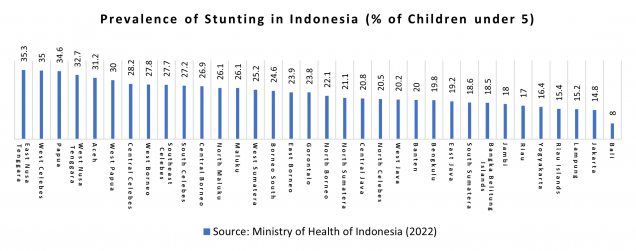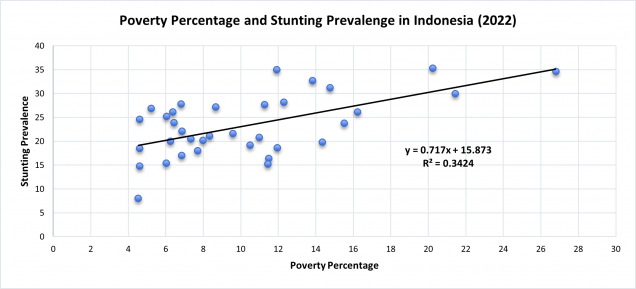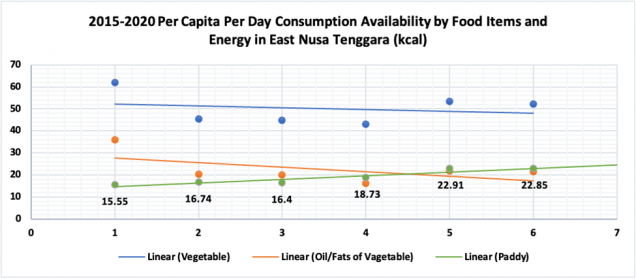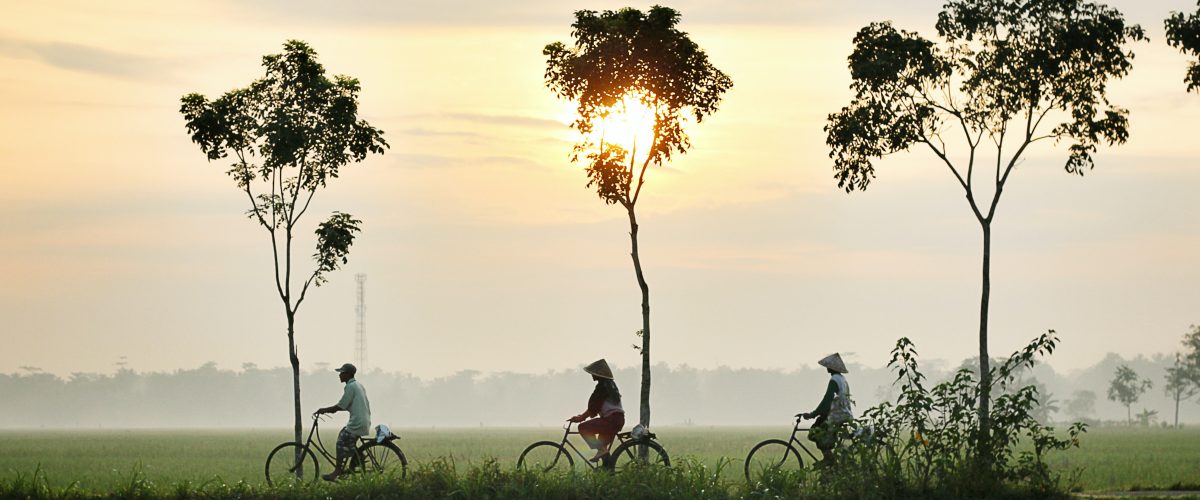Kebumen, Indonesia. Photo by Dikaseva via Unsplash.
By Denztrial Celvin Kehi
Stunting is a condition in which a child’s growth and development are impaired due to poor nutrition, repeated infections, and psychosocial stimulation.1 Children are categorized as stunted if their z-score of height-for-age is more than 2 standard deviations below the World Health Organization (WHO) Child Growth Standards median.2 Globally, 149.2 million children under the age of 5 are estimated to be stunted.3 In other words, 22% of children around the world under the age of five are more likely to have poor development and learning abilities, have a higher susceptibility to non-communicable diseases, and have higher mortality rates.4
In Indonesia, stunting has been a major health challenge for decades. Based on the World Bank estimation model, stunting prevalence amongst children in Indonesia has dropped from 41.5% in 2000 to 31.8% in 2020.5 However, stunting in Indonesia is alarming when compared to global prevalence. Some studies suggest stunting in Indonesia is closely related to socio-economic determinants, such as low parental education, inadequate sanitation infrastructure, and parents’ employment.678
In January 2023, Indonesia’s Ministry of Health claimed success in decreasing the country’s stunting prevalence to 21.6% in 2022.9 Regardless of its stated achievement in addressing stunting, most of Indonesia’s provinces still have a higher prevalence of stunting than the global average, as shown in Figure 1.
Figure 1: : Prevalence of Stunting in Indonesia (% of Children under 5)

According to a census carried out by the Indonesian Central Bureau of Statistics (Badan Pusat Statistik, BPS) in September 2022,10 East Nusa Tenggara (NTT), a province located in the southeastern part of Indonesia, is the third poorest province. The importance of wealth, according to Amartya Sen, lies in the opportunities that are generated as a result of that wealth.11 In other words, poverty affects stunting prevalence in Indonesia because it influences basic household consumption, which is needed to minimize stunting. For example, pregnant women and newborn infants need a sufficient amount of protein intake to decrease the probability of getting stunted. Figure 2 shows how the stunting prevalence of every province in Indonesia is related to their percentage of poverty by 34%.
Figure 2: Poverty Percentage and Stunting Prevalence in Indonesia (2022)

Besides poverty, drought has long been blamed as the main factor of stunting in East Nusa Tenggara. Water shortages and food insecurity may cause famine when drought occurs for one or more seasons. The problem is further exacerbated by a higher dependence on non-irrigated agricultural fields for food production in East Nusa Tenggara. This type of field relies on rainfall intensity, which accounts for 43.47% of the fields in East Nusa Tenggara.12
More specifically, rice has been the main source of carbohydrates in Indonesia since President Soeharto’s administration, the second president of Indonesia. In 1970, Soeharto instituted a policy, known as the Green Revolution project, to make rice a staple food for every province in Indonesia. The policy made two key implementations: mass guidance (Bimas) and mass intensification (Inmas). Consequently, Indonesia’s rice production went from 12.2 tons in 1969 to 25.8 tons in 1984 (Wati et al., 2022). Furthermore, the people of East Nusa Tenggara province, who usually consume corn and sorghum, finally opened their fields to plant rice, although rice production requires large amounts of water. With a newfound dependence on rice production, East Nusa Tenggara needs 800 tons of rice each year,13 but can only produce 443 tons of rice.14 As such, this paper opposes agricultural homogeneity in Indonesia and offers recommendations to decrease stunting prevalence in East Nusa Tenggara.
Stunting and Agricultural Homogeneity
Between 1961 and 2009, 50 crop commodities accounted for 90% of the world’s calories, protein, fat, and weight,15 and in the last 50 years agricultural homogeneity increased by 16.7%.16With increasing agricultural homogeneity, there is a growing interdependence between countries’ food supply. Food security could be compromised as countries become more similar in their consumption of agricultural commodities.
The threats to food security associated with agricultural homogenization could be traced back to the notion of comparative advantage in the context of free trade. Globalization has been catalyzing the movement of goods and services across countries. Trading goods between countries will result in cost reductions if each country specializes in a different type of product.17
However, the concept of comparative advantage does not take into account non-economic factors, such as warfare and the depletion of natural resources. For example, the war in Ukraine, one of the largest exporters of wheat, has caused disruptions in the global wheat supply chain. Thus, sub-Saharan countries, such as Ethiopia and Nigeria, struggled to replace Ukraine’s wheat supplies. A problem worsened as the countries already faced an impending food crisis.
Figure 3: 2015-2020 Per Capita Per Day Consumption Availability by Food Items and Energy in East Nusa Tenggara (kcal)

Natural resource depletion, coupled with agricultural homogeneity, could be another factor leading to stunting in Indonesia, especially in the East Nusa Tenggara province. The country’s production of rice paddy cannot support its high dependence on rice due to the impact of agricultural homogeneity policy. Out of the top 3 per capita per day consumption availability of food items and energy in the province, rice paddy is the only commodity that the trends consistently grow.18According to Figure 3, consumption rose from 15.55 kcal per day per capita in 2015 to 22.85 kcal in 2020. Consequently, East Nusa Tenggara had to import 5,000 tons of rice from Vietnam in 2023.19 As a result, the failure of rice production to meet the needs of the population may result in higher rates of stunting.
Although scholars do not find a direct correlation between agricultural homogenization and stunting, evidence supports dietary diversity as a solution to child malnutrition, aside from other socio-economic factors. Haddad (2000) found a strong connection between agriculture and nutritional status of farmers’ households20Furthermore, Shively and Sununtnasuk (2015) argue that agricultural diversity is important to address stunting in Nepal.21On the other hand, Purwestri et al (2017) failed to find a correlation between lack of agricultural diversity of crops and livestock, and stunting in Demak Regency, Central Java, Indonesia.22However, a cross-sectional survey from the same study in December 2014 to February 2015 asserted a paradox between high rice productivity and poor children’s nutrition. Though high rice productivity does not necessarily correlate with stunting prevalence, Ochola and Masibo (2014) pointed out that children in developing low-middle income countries lack access to affordable dietary diversity.23
As evidenced from Indonesia’s Central Statistics Bureau, for 22 cities/regions in East Nusa Tenggara, the higher the rice production, the greater the prevalence of stunting.24This means homogenizing agriculture crops can lead to a lack of other sources of nutrition.
Figure 4: Stunting Prevalence and Rice Production (Ton)

As previously noted, 43.47% of agriculture fields are traditional, non-irrigated agricultural fields,25 making them more vulnerable to droughts and other climate conditions. Rice fields require large amounts of water throughout the growing season. Given the province’s weather restrictions, like a prolonged summer, East Nusa Tenggara should diversify their agriculture commodities that are appropriate to its topography and climate.
An Alternative to Agricultural in Homogeneity
Sorghum could be an option to diversify the agriculture crops to address drought that causes stunting in East Nusa Tenggara. Unlike rice, the sorghum plant is adaptable to a wide range of environmental conditions. This is primarily for dry lands, such as East Nusa Tenggara, which has only two months of rainfall each year. Sorghum is considered to be an adapted crop for dry climates. The reason for this is that sorghum is tolerant of a wide range of environmental and agronomic conditions, including low precipitation, insufficient irrigation water, and salinity. As a result, sorghum has been found to be less susceptible to climatic fluctuations, allowing it to maintain high productivity while providing food for humans and animals, as well as ensuring food security in tropical regions.26 Due to these factors, sorghum is one of the most suitable food crops for development in East Nusa Tenggara. Yet, as in other provinces, rice has become the main staple food.
Sorghum’s ability to grow in marginal areas makes it very promising for the development of the crop. Moreover, the nutritional value of these foods is equal to that of corn, and, more importantly, these foods were previously consumed by residents of the local area. Aside from conforming to agro-ecology in NTT, sorghum played a significant role in contributing to the achievement of self-sufficiency in food. The cultivation of sorghum has not yet reached the status of the main staple food source in Indonesia, but some regions, such as Rote Ndao and Sumba regencies of NTT, have regulated its cultivation as a priority (Lestari, 2019).27
Summary
Stunting prevalence has consistently decreased in Indonesia as a result of the country’s efforts. However, half of the provinces in Indonesia still have a higher prevalence of stunting than the global average. In addition to having the highest stunting prevalence, East Nusa Tenggara dependence on rice poses a potential threat to children’s nutrition, because agricultural homogeneity of East Nusa Tenggara food supply is in contradiction with the topography and climate of the province.
Adequate nutritional needs for children is as important as addressing other socioeconomic factors that contribute to stunting. The proper diversification of agricultural crops is therefore recommended. Sorghum’s ability to adapt to East Nusa Tenggara’s low rainfall intensity and frequent droughts, and as a previous staple food of the population, makes it the best addition to rice.

Bibliography
[1] WHO, “Stunting in a Nutshell,” World Health Organization, Nov. 19, 2015, https://www.who.int/news/item/19-11-2015-stunting-in-a-nutshell/.
[2] WHO, “Reducing Stunting in Children: Equity Considerations for Achieving the Global Nutrition Targets 2025″. CC BY-NC-SA 3.0 IG, 2015, https://apps.who.int/iris/bitstream/handle/10665/260202/9789241513647-eng.pdf/.
[3] UNICEF DATA, “Malnutrition in Children – UNICEF DATA”, 2023, https://data.unicef.org/topic/nutrition/malnutrition/.
[4] De Sanctis, Vincenzo, Ashraf Soliman, Nada Alaaraj, Shayma Ahmed, Fawziya Alyafei, and Noor Hamed. “Early and Long-Term Consequences of Nutritional Stunting: From Childhood to Adulthood: Early and Long-Term Consequences of Nutritional Stunting”. Acta Biomedica Atenei Parmensis https://doi.org/10.23750/abm.v92i1.11346.
[5] World Bank. “Prevalence of Stunting, Height for Age (Modeled Estimate, % of Children under 5) – Indonesia | Data.”. https://data.worldbank.org/indicator/SH.STA.STNT.ME.ZS?contextual=default&locations=ID.
[6] Laksono, Agung Dwi, Ratna Dwi Wulandari, Nurillah Amaliah, and Ratih Wirapuspita Wisnuwardani. “Stunting among Children under Two Years in Indonesia: Does Maternal Education Matter?” Edited by Marcello Otake Sato. PLOS ONE 17, no. 7, July 25, 2022 https://doi.org/10.1371/journal.pone.0271509.
[7] Mediani, Henny Suzana. “Predictors of Stunting Among Children Under Five Year of Age in Indonesia: A Scoping Review.” Global Journal of Health Science 12, no. 8, June 8, 2020. https://doi.org/10.5539/gjhs.v12n8p83.
[8] Torlesse, Harriet, Aidan Anthony Cronin, Susy Katikana Sebayang, and Robin Nandy. “Determinants of Stunting in Indonesian Children: Evidence from a Cross-Sectional Survey Indicate a Prominent Role for the Water, Sanitation and Hygiene Sector in Stunting Reduction.” BMC Public Health 16, no. 1, July 29, 2016. https://doi.org/10.1186/s12889-016-3339-8.
[9] Rokom.“Prevalensi Stunting Di Indonesia Turun Ke 21,6% Dari 24,4%.” Kementrian Kesehatan, January 25, 2023. https://sehatnegeriku.kemkes.go.id/baca/rilis-media/20230125/3142280/prevalensi-stunting-di-indonesia-turun-ke-216-dari-244/.
[10] BPS. Rokom.“Percentage of Poor Population (P0) by Province and Area 2021-2022.” Accessed March 15, 2023. https://www.bps.go.id/indicator/23/192/1/persentase-penduduk-miskin-menurut-provinsi.html.
[11] Health Assembly, 52 World. “Health in Development: Keynote Address by Professor Amartya Sen, Master of Trinity College, Cambridge, Nobel Laurate in Economics, to the Fifty-Second World Health Assembly, Geneva, Tuesday, 18 May 1999.” Health in development: keynote address by Professor Amartya Sen, Master of Trinity College, Cambridge, Nobel Laurate in Economics, to the fifty-second World Health Assembly, Geneva, Tuesday, 18 May 1999, January 1, 1999. https://apps.who.int/iris/handle/10665/79397.
[12] BPS. “Area of Wetland by Regency/City and Type of Irrigation in Nusa Tenggara Timur Province (Hectare), 2017-2020.” Accessed March 15, 2023. https://ntt.bps.go.id/indicator/53/110/1/luas-lahan-sawah-menurut-kabupaten-kota-dan-jenis-pengairan-di-provinsi-nusa-tenggara-timur.html.
[13] Bisnis.com.“Wilayah NTT Membutuhkan 800.000 Ton Beras per Tahun,” May 9, 2017. https://bali.bisnis.com/read/20170509/538/774644/wilayah-ntt-membutuhkan-800.000-ton-beras-per-tahun.
[14] BPS.“Rice Production by Regency/Municipality (Tons), 2020-2022,” Accessed March 15, 2023. https://ntt.bps.go.id/indicator/53/934/1/produksi-beras-menurut-kabupaten-kota.html.
[15] Khoury, Colin K., Anne D. Bjorkman, Hannes Dempewolf, Julian Ramirez-Villegas, Luigi Guarino, Andy Jarvis, Loren H. Rieseberg, and Paul C. Struik. “Increasing Homogeneity in Global Food Supplies and the Implications for Food Security.” Proceedings of the National Academy of Sciences 111, no. 11 March 3, 2014 https://doi.org/10.1073/pnas.1313490111.
[16] Ibid.
[17]Ricardo, David, 1772-1823. On the Principles of Political Economy and Taxation. London: John Murray, 1817.
[18]BPS.“Per Capita per Day Consumption Availability by Food Items and Energy (kkal/cal), 2015-2020.” Accessed March 15, 2023. https://ntt.bps.go.id/indicator/53/516/2/ketersediaan-pangan-untuk-konsumsi-per-kapita-sehari-menurut-kelompok-bahan-makanan-dan-energi.html.
[19]Ernesto, Yufen. “NTT Terima 5.000 Ton Beras Impor Asal Vietnam.” detikbali, 2023. https://www.detik.com/bali/nusra/d-6514459/ntt-terima-5000-ton-beras-impor-asal-vietnam.
[20]Haddad, Lawrence. “A Conceptual Framework for Assessing Agriculture–Nutrition Linkages.” Food and Nutrition Bulletin 21, no. 4 (January 2000): 367–73. https://doi.org/10.1177/156482650002100405.
[21]Shively, Gerald, and Celeste Sununtnasuk. “Agricultural Diversity and Child Stunting in Nepal.” The Journal of Development Studies 51, no. 8 (August 3, 2015): 1078–96. https://doi.org/10.1080/00220388.2015.1018900.
[22]Purwestri, Ratna Chrismiari, Loretta Renz, Nia Novita Wirawan, Ignasius Radix A. P. Jati, Ilmia Fahmi, and Hans Konrad Biesalski. “Is Agriculture Connected with Stunting in Indonesian Children Living in a Rice Surplus Area? A Case Study in Demak Regency, Central Java.” Food Security 9, no. 1 January 13, 2017: 89–98. https://doi.org/10.1007/s12571-016-0634-2.
[23]Ochola, Sophie, and Peninah Kinya Masibo. “Dietary Intake of Schoolchildren and Adolescents in Developing Countries.” Annals of Nutrition and Metabolism 64, no. Suppl. 2 (2014): 24–40. https://doi.org/10.1159/000365125.
[24]BPS. “Rice Production by Regency/Municipality (Tons), 2020-2022.” Accessed March 15, 2023. https://ntt.bps.go.id/indicator/53/934/1/produksi-beras-menurut-kabupaten-kota.html.
[25]BPS. “Area of Wetland by Regency/City and Type of Irrigation in Nusa Tenggara Timur Province (Hectare), 2017-2020.” Accessed March 15, 2023. https://ntt.bps.go.id/indicator/53/110/1/luas-lahan-sawah-menurut-kabupaten-kota-dan-jenis-pengairan-di-provinsi-nusa-tenggara-timur.html.
[26]Hossain, Md. Saddam, Md. Nahidul Islam, Md. Mamunur Rahman, Mohammad Golam Mostofa, and Md. Arifur Rahman Khan. “Sorghum: A Prospective Crop for Climatic Vulnerability, Food and Nutritional Security.” Journal of Agriculture and Food Research 8 (June 2022): 100300. https://doi.org/10.1016/j.jafr.2022.100300.
[27]Hossain, Md. Saddam, Md. Nahidul Islam, Md. Mamunur Rahman, Mohammad Golam Mostofa, and Md. Arifur Rahman Khan. “Sorghum: A Prospective Crop for Climatic Vulnerability, Food and Nutritional Security.” Journal of Agriculture and Food Research 8 (June 2022): 100300. https://doi.org/10.1016/j.jafr.2022.100300.
